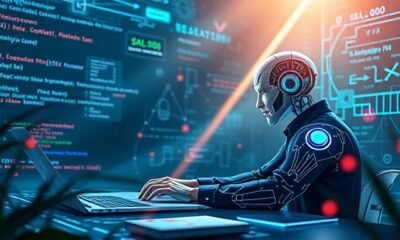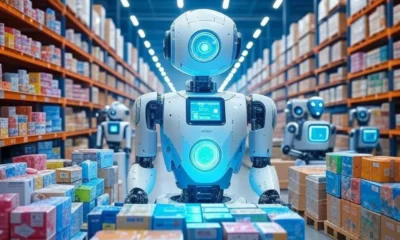Artificial Intelligence
Why Predictive AI in Reverse Logistics Matters for B2C Brands
Predictive AI is transforming reverse logistics for U.S. B2C brands by cutting costs, improving speed, and boosting customer trust. Learn how AI-driven returns management can create efficiency, prevent fraud, and support eco-friendly business practices.
I bought a pair of shoe online a few days ago and shipped it back due to it not fitting at all. Shipping back was several days late and cost me additional shipping costs and to be frank, I was not keen to purchase that brand again. In case of B2C brands, each late refund or slackening piece of exchange implies to lose repeat buyers and to waste useful operation resources.
Definition:
Predictive AI in reverse logistics uses advanced algorithms to forecast returns, optimize handling, and improve customer satisfaction.
Predictive AI has the potential to turn returns into an expeditious, unstressed, and even the customer-satisfying brand encounter.
It enables it to save money by anticipating patterns of returns and streamlining the workflows to ensure satisfied and loyal customers in your store.
What is Reverse Logistics of B2C Brands?
Reverse logistics involves returning of products to the brand by the customers requiring replacements, repairing or recycling of the goods.
This is usually more cumbersome in the B2C environment as a result of increased levels of returns and the different customer expectations.
It involves several actions that comprise the product inspection, quality check, restocking, reconditioning, and even safe disposals in case of any unsalable products.
In the case of brands, every extra step introduces costs and delays and having a smooth handling as a priority is vital, in order to stay profitable.
The B2C brands in the United States have a special condition due to quick refunds and easy return policies demanded by the customers.
To meet these demands, there should be a balance between operational set up and cost of moving, storing and the possible product loss.
How Predictive AI Can Be Applied to Reverse Logistics?
Working on predictive AI involves the use of past data of returns as well as real-time information on sales products that may most likely cause returns. It will enable the brands to budget, manage stocks, and decrease the total amount of costs and time in order to process returns.
It applies machine learning algorithms, predictive analytics (and on occasion natural language processing) to discern the patterns of customer behaviour. When you identify trends early enough, it can make brands make preventive measures that reduce the rate of returns and make operations efficient. This is quicker in processing and causes a smaller error rate among humans causing faster refund and customer satisfaction.
Can Predictive AI be the Answer to Return Rates in B2C brands:
Predictive AI also has the potential to lessen returns since it can give individual suggestions to a customer about the product according to their taste and purchase behavior. Once customers have received products that suit their needs more, they will not be much inclined to send them back.
Through customer behavioural analysis, predictive AI is able to detect recurrent buyers so as to recommend solutions that could respond to their purchases. Given targeted intervention can not only contribute to a decrease in returns, but also to the enhancement of brand relationships with loyal customers.
How Predictive AI Can Increase Speed of Return Processing?
Using predictive AI allows the processing of returns much faster, as it directs dispatched products to the closest and most appropriate processing center automatically. This saves shipping time, costs and puts the product in inventory or recycling much sooner.
Through forecasting of demand in the future, AI focuses on restocking those items that are more likely to sell again so that popular products do not end up remaining in the shelves.
Relevance of Fraud Detection in reverse logistics:
About U.S. B2C brands, their return fraud is an expensive issue and it can substantially decrease aggregate profit margins. Cases of fraud encompass returning used product, stolen merchandise or counterfeited goods to demand undeserved returns.
Predictive AI flags the suspicious activity based on the pattern of orders, and their frequency of returns, and the abnormal behaviour of the customer in real time. This enables brands to intervene early than the processing of fraudulent returns and this saves them money and also inventory.
It also minimizes erroneous accusations since it does not wrongly flag legitimate customers in an effort to detect fraud. Such equilibrium of prevention and trust is crucial in solid customer relationships over a long period of time.
Is Predictive AI Able to Make Reverse Logistics more Sustainable?
Predictive AI has the potential to help the reverse logistics become eco-friendly since it can optimize the transportation of returns to negate excessive transportation and fuel usage. This will reduce the carbon footprint on shipping and makes the logistics greener.
It also forecasts what products may become refurbished or sold again, so that there is no unnecessary entry of items into landfills. In this way, brands will be able to reduce waste and derive additional value out of returned goods.
Sustainability reports that are generated by AI enable a company to calculate its environmental impact and trace its progress regarding eco-friendly objectives. Such insights will enable B2C brands to be at par with the increasing consumer interests in environmental conscious business practices.
What Are the Real-World Results of Predictive AI in Reverse Logistics?
One U.S.-based fashion company was able to drive down returns by 20 percent following the implementation of predictive AI to make more accurate sizing suggestions. Shift enhanced the satisfaction of customers and reduced the operating costs through shipping and processing wastages.
An electronics retailer reduced its costs to process returns by 30 percent through AI-assisted return routing and quality checks that were automated. This had the effect of improving refund speed and reutilization of returned goods to increase customer loyalty.
Following examples demonstrate how predictive AI can provide quantifiable outcomes to turn reverse logistics into a competitive advantage in the real world.
How Can B2C Brands Start Using Predictive AI in Reverse Logistics?
First, you will have to gather and clean up old return data so that the AI system can get the right and trustworthy information.
Correct predictions can be based on good data hence preventing costly mistakes.
Second, use predictive AI to harmonize returns with your warehouse and inventory control systems to facilitate and auto-process returns.
This will make the AI capable of decision making based on real information without interfering with the usual functions.
What are the Challenges that You will face in using predictive AI?
Among the greatest issues is the privacy of data, where the U.S. has enforced stringent laws such as CCPA to safeguard the details of customers.
Brands should also make sure that AI systems are used to process the personal data safely and within the confines of all the current laws.
They may also be challenging to integrate with older systems, thus leading to delays or lack of compatibility in the AI adoption process.
There can be the need to invest additional funds in the upgrade of technology or customization of software.
The other issue is that there is a tendency to over trust on flawed forecasts, this might make wrong business choices.
Complementing AI with human judgment is a must to the optimal performance.
What Does the Future Look Like for Predictive AI in Reverse Logistics?
Predictive AI and blockchain will be used to identify whether products sent back to a company are genuine in the future.
This will enhance confidence between the customers and brands and minimize scam returns. Customers and businesses will find the process to be convenient and faster using this kind of automation.
In the long term, reverse logistics that reuse or recycle all returned products might become automated, with no waste, thanks to predictive AI.
Vision is in line with the increasing efficiency and environmental steward demands in the U.S. market.
To conclude, converting Returns into a Strategic Advantage with Predictive AI.
Reverse logistics can be transformed with predictive AI that turns it into an inexpensive feature of enhancing brand trust and operational effectiveness. It is providing the B2C brands with a competitive edge in the modern world market by prediction of returns, process optimization, and enhanced sustainability.
Technology relieves expenses, accelerates returns, and assists in maintaining customers satisfied by ensuring the ease and transparency of their returns. It also promotes environmental friendly objectives which most consumers in the U.S. have come to demand of their preferred brands.Any improvement can bring a sustainable positive effect on the image of the brand and on the customers. What in the processing of returns of products poses the greatest challenge to you in your business? Have you ever considered AI to help your reverse logistics process? What are your predictions regarding how predictive AI will transform returns to B2C brands in the short term (the next five years)?
-

 Artificial Intelligence8 months ago
Artificial Intelligence8 months agoHow to Use Grok AI: A Complete Guide
-

 Artificial Intelligence10 months ago
Artificial Intelligence10 months agoWhat is Artificial Intelligence? A Comprehensive Guide for Businesses and Enthusiasts
-

 Artificial Intelligence9 months ago
Artificial Intelligence9 months agoUnlocking the Power of Artificial Intelligence Tools
-

 Artificial Intelligence9 months ago
Artificial Intelligence9 months agoWhat is DeepSeek? Revolutionizing AI with Cutting-Edge Solutions
-

 Artificial Intelligence5 months ago
Artificial Intelligence5 months agoAI Technologies in Warehouse Automation:
-

 Artificial Intelligence5 months ago
Artificial Intelligence5 months agoPredictive Analytics for Demand Forecasting:
-

 Artificial Intelligence6 months ago
Artificial Intelligence6 months agoMeta’s AI Push: The Standalone Assistant App Set to Rival ChatGPT
-

 Artificial Intelligence5 months ago
Artificial Intelligence5 months agoHow Artificial Intelligence is Revolutionizing Logistics:


